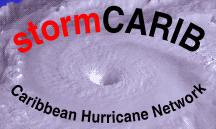|
Bridgetown, Barbados October 16, 2008 (CDERA)- Late yesterday, October 15, into this morning Thursday, October 16, 2008, Anguilla, Antigua & Barbuda, the British Virgin Islands(BVI), Montserrat, Saint Kitts & Nevis and were impacted by a Category Three Hurricane Omar.
At 11:00am AST today, the centre of Hurricane Omar was situated at latitude 20.2 north, longitude 61.3 west, or about 180 miles (290 km) north east of the Northern Leeward Islands. All warnings for St. Kitts and Nevis, Antigua and Barbuda, Anguilla, Montserrat and BVI have been discontinued.
Omar is expected to produce additional rainfall amounts of 1 to 3 inches with a maximum of 6 inches over portions of the region from Antigua southwards to Martinique.
THE SITUATION:
Anguilla: An all clear was issued at 8:00am this morning by the Department of Disaster Management (DDM). Air and sea ports remain closed due to minor flooding and rough seas respectively; however the Airport is scheduled for re-opening later today.
The Department’s preliminary report indicates minor damage to the island with some roof damage to two hotels, severe beach erosion, downed trees and utility poles. Three cargo ships and seven boats have run around while two boats have sunk.
A Damage Assessment Needs Analysis (DANA) team is reviewing the damage and debris clearance teams are already clearing roads.
There was loss of electricity in parts of the island. The DDM reports that 95 % of the island’s electricity supply will be restored within 72 hours. Mobile phones remain operational and there have been some reports of land line outage due to downed poles.
Antigua & Barbuda
The National Office of Disaster Services in Antigua has reported that there is widespread flooding across the island which is making some roads impassable. Damage assessments are currently being carried out.
Preliminary assessment indicates some damage to roads; minimal wind damage and some fallen trees. Coordinators in three districts have been advised to open shelters and the public has been advised to remain indoors.
Rescue operations are ongoing for residents in low lying areas.
British Virgin Island:
At 5:00am this morning, the National Emergency Operations Center (NEOC) issued the “All Clear” for the Territory. The Airport will resume full operation by 2pm today.
No damage has been reported to the water supplies.
The NEOC’s preliminary damage assessment indicate there the have been some minimal damage to the island, some minor flooding, rock fall and broken trees. A full damage assessment is now being conducted.
The Deputy Governor has issued a statement advising residents to remain off the roads to allow for the assessment to be carried out and for road clearance and the restoration of critical services. He has advised that the NEOC will remain activated throughout the day and will stand down at 5:00pm today.
Montserrat: The Disaster Management Coordination Agency is reporting that the island continues to be affected by rains. An Assessment Team is currently carrying out preliminary damage assessments. So far only minimal damage has been reported. Telephone and electricity supplies have suffered no damage. Schools remain closed.
Minor landslides have been reported in some areas due mainly to excessive rainfall. These have now been cleared by Public Works. There is concern that there could be additional landslides due to the high level of saturation and the continuing rainfall.
The Governor met with the National Disaster Preparedness and Advisory Committee on Wednesday (Oct. 15) and residents of Zone B were evacuated due to their proximity to Belham River which is prone to Lahars as well as the possibility of a dome collapse at the Soufriere Hills Volcano.
St. Kitts and Nevis:
In St. Kitts, there are reports of blocked roads and minor damage to homes. Initial reports indicate that there is no electricity due to downed power lines. There is some damage to St. Christopher Sea Port and severe beach erosion along the western coastline and Frigate Bay.
The R.L. Bradshaw International Airport was expected to reopen at noon on Thursday Oct 16.
On Nevis: The pier at Qualie Beach was destroyed and two passenger vessels reportedly ran aground and sustained severe damage. The electricity supply is reportedly off due to downed power lines and there are blocked roads.
Damage assessment teams and clean-up crews are currently on the ground on both islands.
REGIONAL RESPONSE:
The Caribbean Disaster Emergency Response Agency Coordinating Unit (CDERA CU) has been in contact with the countries affected by Hurricane Omar and continues to monitor the situation closely. The CDERA CU has also been in contact with the Regional Security System (RSS) and the Eastern Caribbean Donor Group (ECDG).
The Eastern Caribbean Donor Group meeting which was scheduled for today Thursday 16 October 2008 at 3:30 p.m. has been cancelled. The ECDG has agreed to concentrate its efforts through the CDERA CU.
The Regional Response Mechanism remains on standby to ensure their availability should this become necessary after full assessments have been undertaken.
The RFA Wave Ruler will deploy a helicopter to undertake fly-overs for the British Virgin Islands and Anguilla later today. The ship remains ready to provide assistance should the need arise.
Contact Details: The CDERA CU 24hr contact number is 246 425 0386
| 
